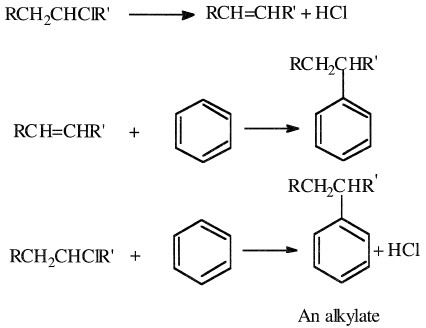


 علم الكيمياء
علم الكيمياء 
 الكيمياء التحليلية
الكيمياء التحليلية 
 الكيمياء الحياتية
الكيمياء الحياتية 
 الكيمياء العضوية
الكيمياء العضوية 
 الكيمياء الفيزيائية
الكيمياء الفيزيائية
 الكيمياء اللاعضوية
الكيمياء اللاعضوية 
 مواضيع اخرى في الكيمياء
مواضيع اخرى في الكيمياء
 الكيمياء الصناعية
الكيمياء الصناعية |
Read More
Date: 28-8-2017
Date: 13-2-2016
Date: 9-5-2016
|
CHLORINATION OF n-PARAFFINS (Chloroparaffins)
Chlorination of n-paraffins (C10-C14) in the liquid phase produces a mixture of chloroparaffins. Selectivity to monochlorination could be increased by limiting the reaction to a low conversion and by decreasing the chlorine to hydrocarbon ratio. Substitution of secondary hydrogen predominates. The reaction may be represented as:

Monochloroparaffins in this range may be dehydrochlorinated to the corresponding monoolefins and used as alkylating agents for the production of biodegradable detergents. Alternatively, the monochloroparaffins are used directly to alkylate benzene in presence of a Lewis acid catalyst to produce alkylates for the detergent production. These reactions could be illustrated as follows:

Polychlorination, on the other hand, can be carried out on the whole range of n-paraffins from C10-C30 at a temperature range of 80–120°C (using a high Cl2/paraffin ratio). The product has a chlorine content of approximately 70%. Polychloroparaffins are used as cutting oil additives, plasticizers, and retardant chemicals.



|
|
|
|
التوتر والسرطان.. علماء يحذرون من "صلة خطيرة"
|
|
|
|
|
|
|
مرآة السيارة: مدى دقة عكسها للصورة الصحيحة
|
|
|
|
|
|
|
عقد جلسة حوارية عن ضحايا جرائم التطرف ضمن فعاليات اليوم الثاني لمؤتمر ذاكرة الألم
|
|
|